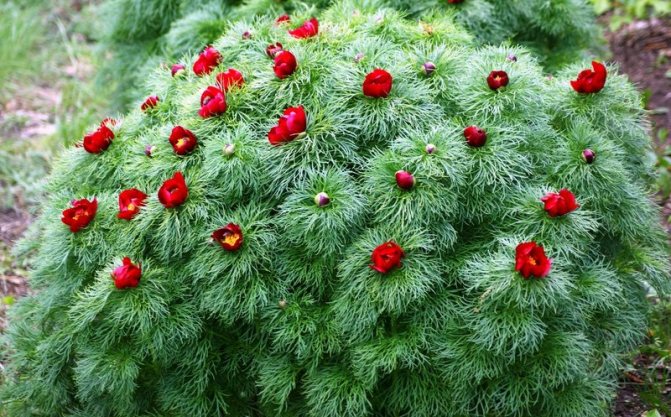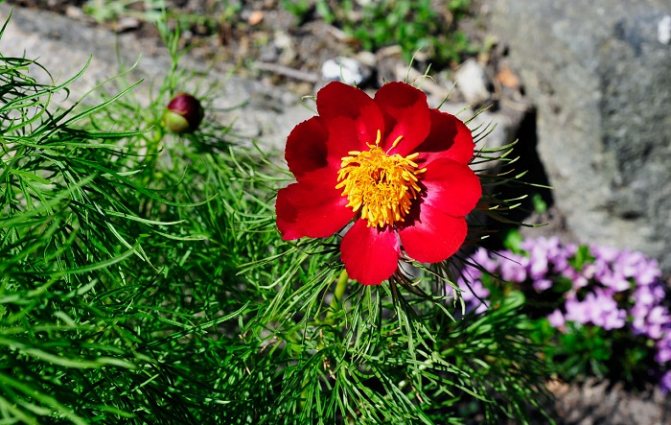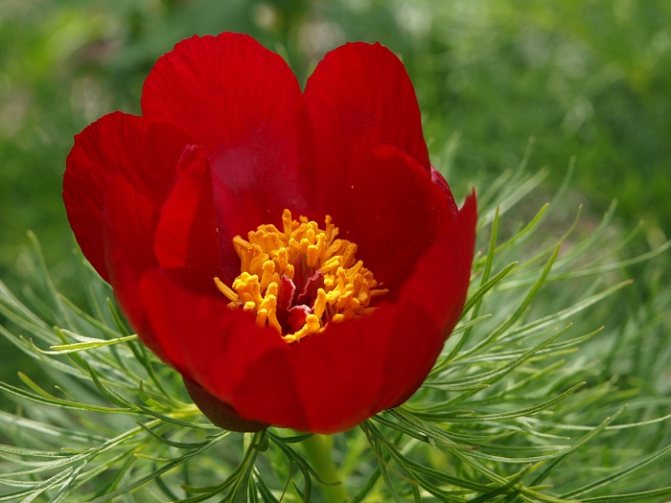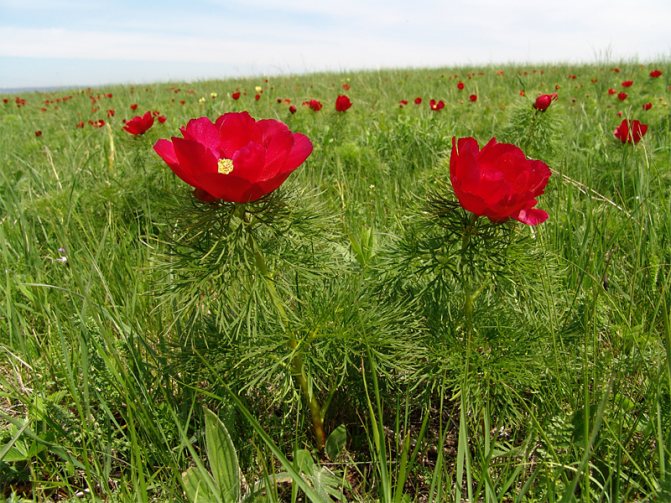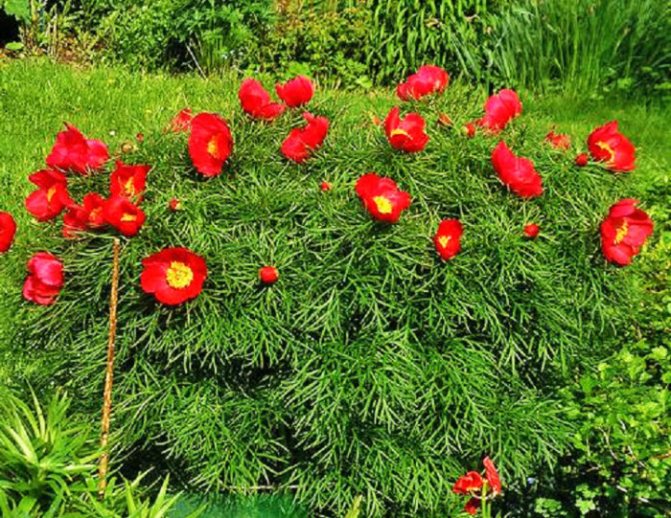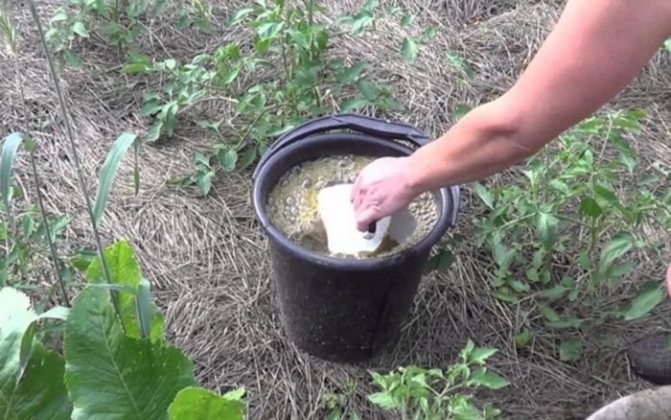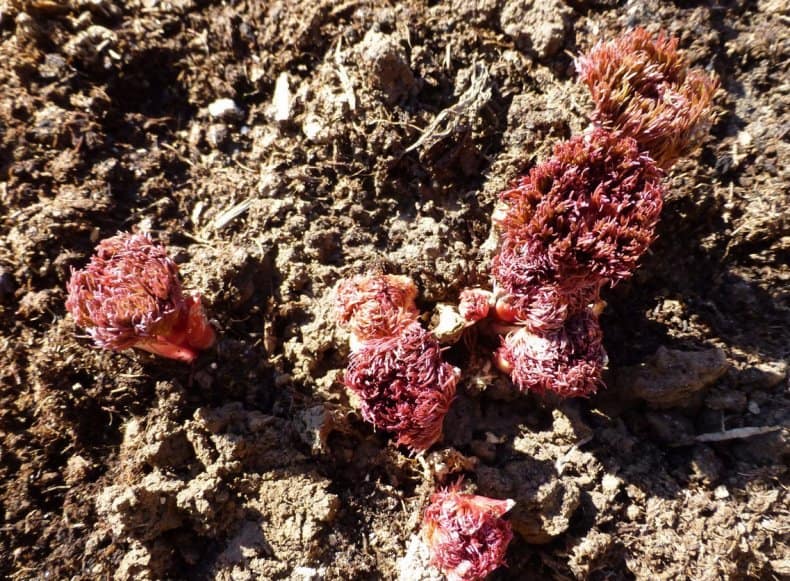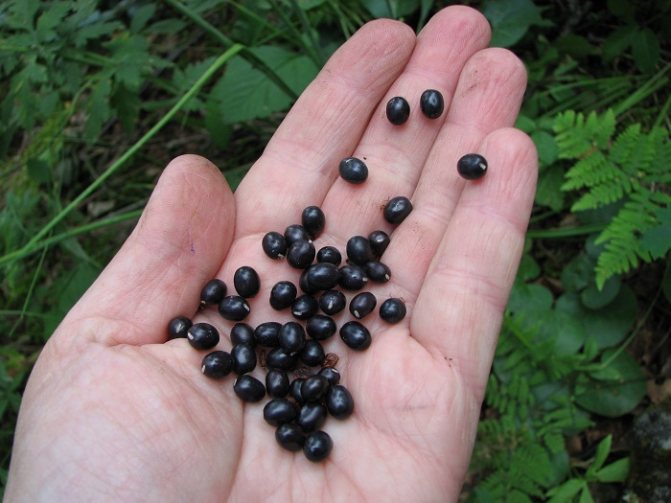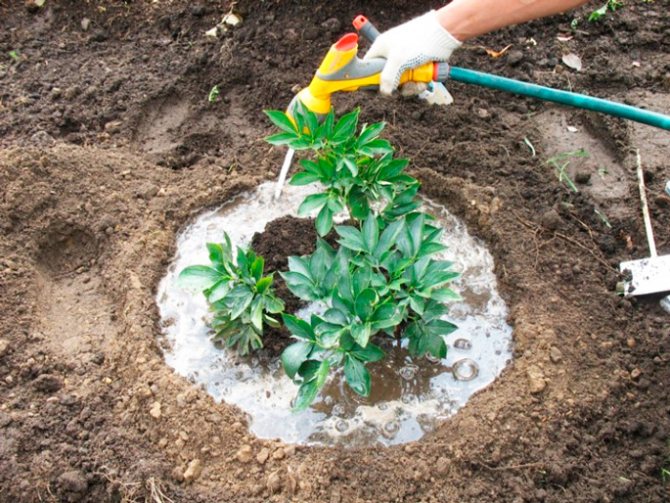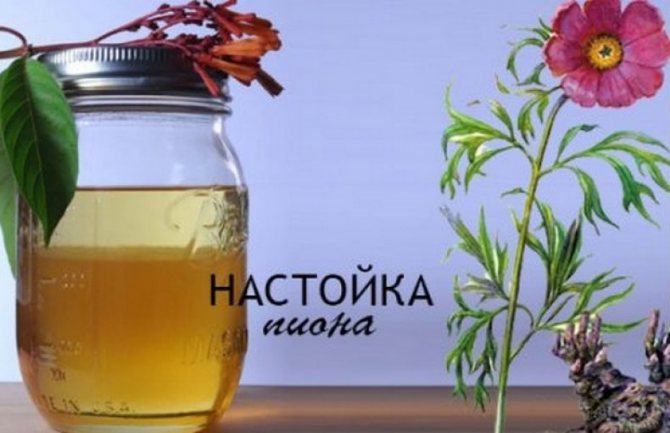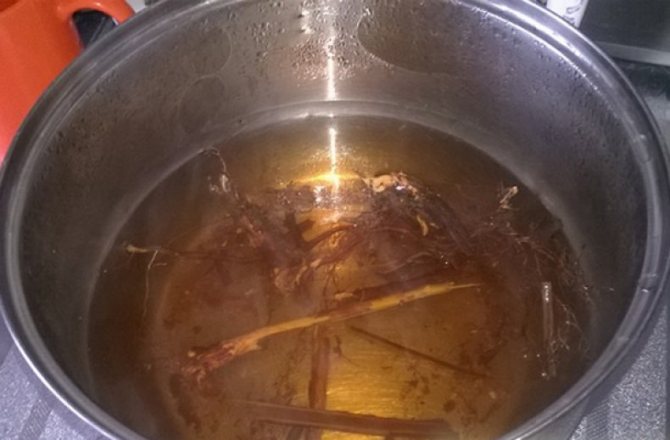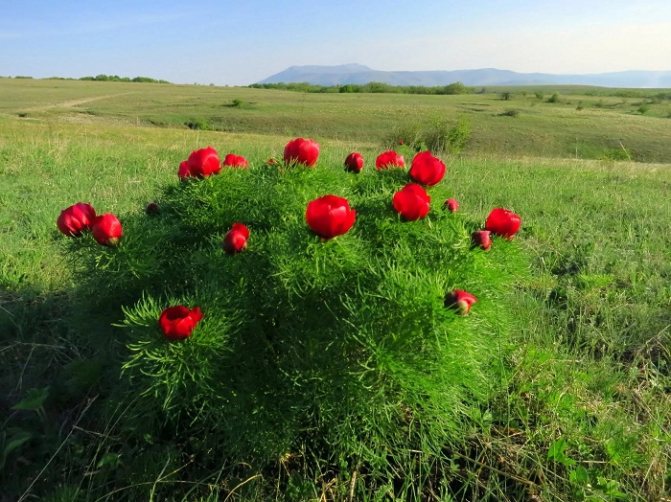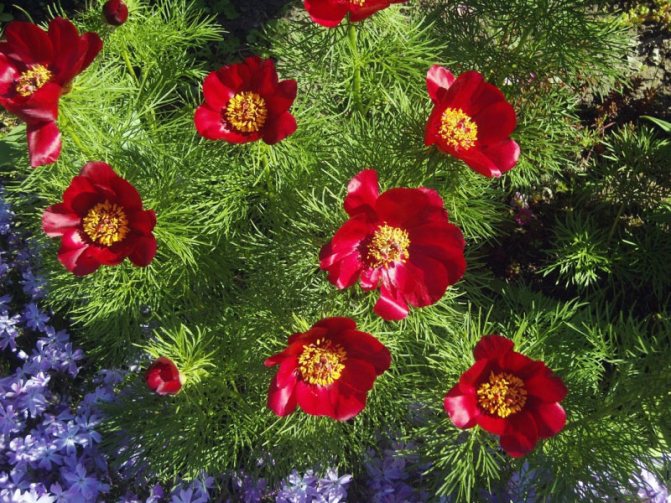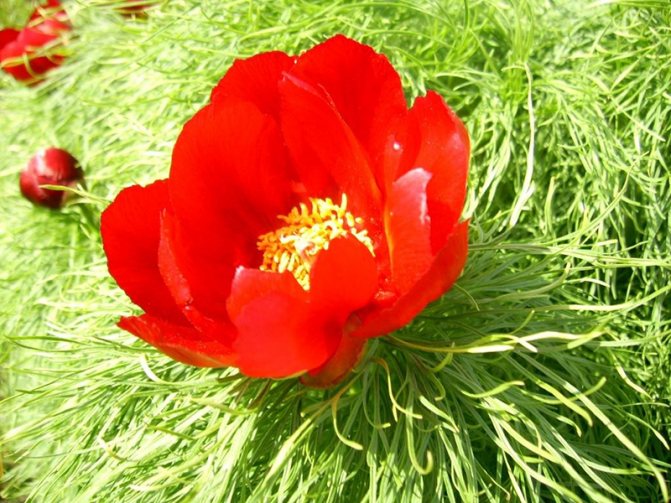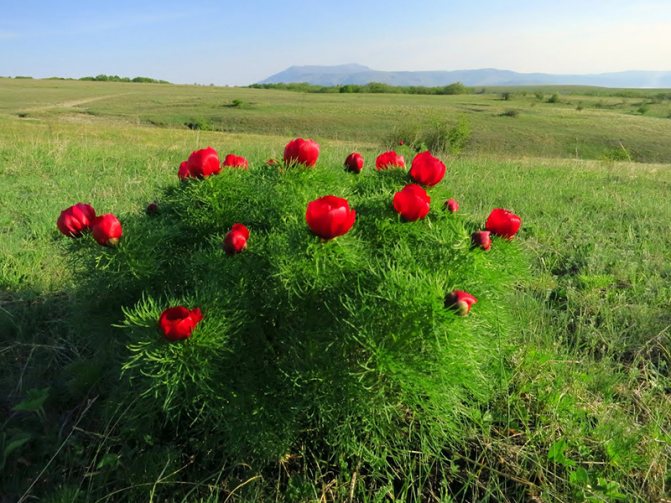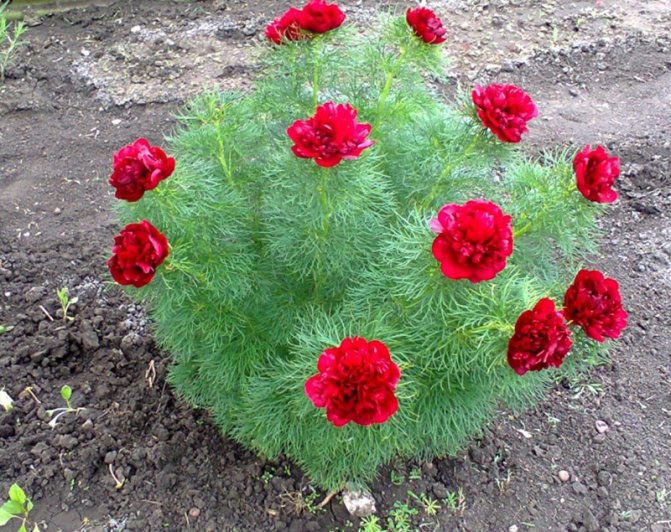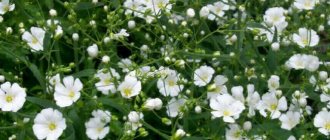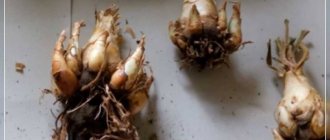Features and morphological description of thin-leaved peony
The peony family has a huge number of varieties, which differ in the structure of the bush, leaves, stem height, size and color of inflorescences. Many gardeners prefer newfangled varieties of peonies with large and double bright flowers and spherical compact bush, but lovers of naturalness and wild landscape design on their site will definitely turn their attention to the exquisite beauty of the thin-leaved peony, which in recent years has been very popular in Canada and the USA ...
The fine-leaved peony is a perennial herb that belongs to the large genus Peonies and the Buttercup family. The very name of the peony comes from the name of the ancient Greek hero Payon, who at one time healed people with the help of this flower. Thin-leaved peony in Russia is known under different names. Among them, one can note the raven, funnels, azure flower, greenery, red lazoric.
Where does the thin-leaved peony grow - a bright and delicate flower that pleases gardeners with early flowering, even in the climatic conditions of Siberia. Today this is a rather difficult question, since because of its healing properties in the 60-70s it was pretty much exterminated, so after a while it was entered into the Red Book of the RSFSR, USSR and Russia. At the moment, it can be found in nature very rarely, mainly in the southern regions of Russia: in the Tambov region, Voronezh and Belgorod regions, where the thin-leaved peony grows in forests and forest-steppe. The homeland of this beautiful flower is the territory of South-Eastern Europe and the Caucasus. Despite the fact that the thin-leaved peony is listed in the Red Book, it can be grown in gardens and flower beds using purchased seedlings. It has been used in culture since the 18th century.
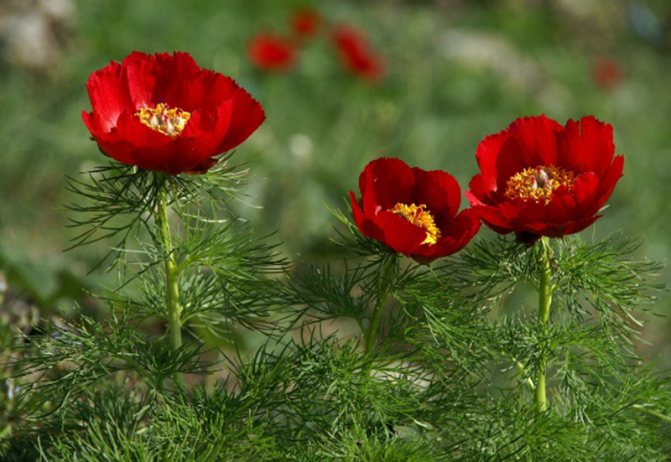
Thin-leaved peony has a very beautiful decorative appearance due to thin needle-shaped leaves, compact spherical bushes and bright red inflorescences. Because of its delicate foliage in the United States, this flower is called the fern peony.
Description of thin-leaved peony:
- The thin-leaved or narrow-leaved peony is a herbaceous plant, which is one of the first to appear from under the snow in small pinkish sprouts. In one place, this plant can grow up to 15 years, growing every year and releasing more and more inflorescences.
- The root system of the thin-leaved peony is of medium length and a thickened edge. In appearance, the roots resemble oblong potato tubers.
- The thin-leaved peony bush has a beautiful and regular compact spherical shape, which grows more and more over time.
- The plant can reach a height of about 40-50 cm over the summer, after which, around August, the entire aerial part dies off, only the roots of the fine-leaved peony remain.
- On the stems of peony, openwork leaves grow in large numbers - the main decoration of the culture. They are moderately long, twice or thrice dissected, very thin, threadlike. In appearance, they resemble fern leaves.
- The color of the leaves is bright green, saturated, so the thin-leaved peony looks spectacular in the garden even after flowering.
- Each thin needle-like leaf can be approximately 2 mm wide. They, like an edge, surround each flower, giving the plant an even greater decorative look.
- Peony flowers are thin-leaved red saturated color, there are burgundy, pinkish shades. Inflorescences average about 8-10 cm in diameter. Consists of 5 petals and a large number of golden anthers in the center. Among the varietal diversity of this culture, there are also thin-leaved terry peonies, which differ not only in the beauty of their flowers and longer flowering duration.
- Flowers bloom at the ends of the stems, one bud each. Flowering occurs around May. At the same time, flowering lasts only an average of 4-10 days, depending on the specific variety. If we talk about terry varieties, then they bloom for about 2 weeks.
- The fine-leaved peony boasts a wonderful scent that cannot be compared with any other scent created by man.
- Around July or August, in place of flowers, the fruits of the peony appear, which are a seed box, which consist of 2-5 leaflets. They contain the black-brown seeds of the plant, from which the popular name of the thin-leaved peony - Voronets comes from.
- Already at the end of July, the bush begins to fall apart and lose its shape, and in August the ground part completely dies off.
- The thin-leaved peony is known for its frost resistance and sufficient unpretentiousness.
- It should be remembered that this wild plant is officially listed in the Red Book of Russia, therefore, it is forbidden to graze livestock and engage in construction in the places where it grows.
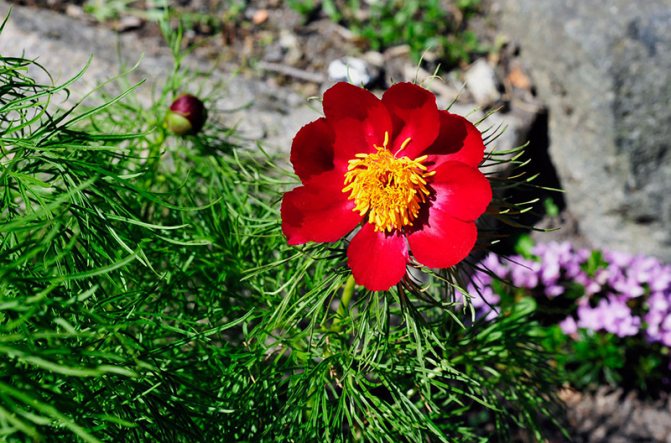

Imagining what a thin-leaved peony looks like, you can come up with a wonderful and unique landscape design with the participation of this flower. At the same time, you can admire not only flowers, but also decorative openwork leaves, which will also be an excellent decoration for the garden.
Transplanting an adult bush
It is advisable not to transplant a healthy bush without visible problems at all. But if necessary, the bush is transplanted in the spring or in August-September with a lump of earth or the transplant is combined with the division and reproduction of the bush.
For a non-traumatic plant transplant, an annular ditch of the largest possible diameter is dug (at least 10-15 centimeters from the projection of the crown), the bush is gently lifted from several sides onto shovels or a sheet of metal is started up under it with the help of a tunnel and an annular ditch (a snow shovel is suitable), which the plant is transported to a new location. Planting is done according to the same rules as an ordinary seedling.
Variety of fine-leaved peony varieties
The fine-leaved peony, like many other species of this family, has long been grown in gardens and flower beds, so breeders from all over the world are busy breeding spectacular and more resistant hybrid varieties. The fine-leaved peony plant also has a number of forms and varieties that have taken root in the areas of avid gardeners, especially in Western Europe and America. Consider the most popular and beautiful varieties of thin-leaved peony.
- Thin-leaved peony "Eaglet". This is a very well-known variety of peony thin-leaved in Soviet times, which was grown in many gardens. It was bred in 60 years. In height, the bush can reach about 55-60 cm, it is a compact spherical bush with a large number of filamentous leaves.The flowers are about 8 cm in diameter, have a bright red color and yellow stamens.
- Peony thin-leaved "Earley Scout". It is also a fairly popular plant variety, which is a bush up to 45-50 cm high in a compact rounded shape. It is distinguished by beautiful large cherry-colored flowers, which can reach 10 cm in diameter. The leaves are openwork, dark green in color, and consist of short filiform leaves.
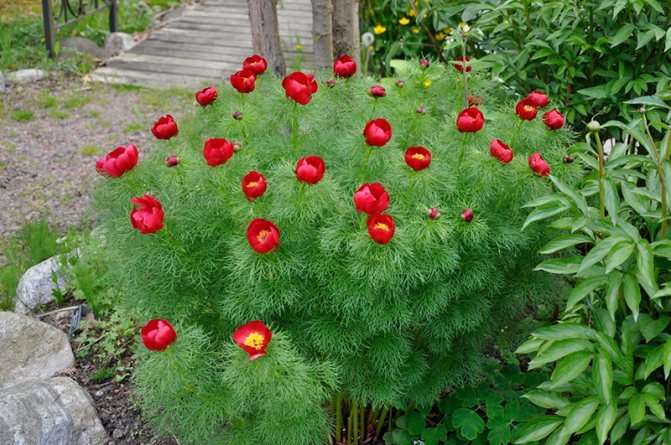

- Peony thin-leaved "Tiny Tim". It is a hybrid variety of this peony. They will differ in almost the earliest flowering. In height, the bush can reach a maximum of 30 cm, is formed by slightly deviating stems with a large number of leaves. Leaves can grow almost close to the ground. Flowers reach 8-10 cm in diameter, semi-double in shape, saturated red.
- Thin-leaved peony "Merry Meyshine". It is also a hybrid variety, which is distinguished by beautiful large flowers of a bright ruby hue, reaching a diameter of about 15 cm. The plant reaches a height of about 55-60 cm, formed by straight, erect stems. The variety begins to bloom early.
- Thin-leaved peony "Kid". This is a plant with simple-shaped flowers, which reach an average of 12 cm in diameter. The flower is distinguished by a bright reddish-carmine shade with a light bluish base. Stamens with pink filaments and yellow anthers look beautiful against the background of the petals. The peony reaches a height of about 50-55 cm, is formed by slightly deviating stems. A very early variety that pleases not only with its beautiful flowers, but also with its openwork dark green shiny foliage.
- Little Rhyme thin-leaved peony variety. The bush of this variety can grow about 40 cm in height, which makes it simply irreplaceable for rocky gardens and alpine slides. The shape of the flowers is simple, the petals are purple-red. The diameter of each inflorescence can be about 12 cm. The bush is formed by erect shoots, so it is compact and spherical in shape. The foliage is openwork, dissected, of a grayish-green hue. Differs in early flowering and growing season.
- Peony thin-leaved "Captivity". A very beautiful terry peony of this variety. It can reach a height of about 40-50 cm, the bush is formed by erect stems and openwork threadlike leaves of a dark green hue. Flowers are densely double, bright crimson color. Differs in rather early flowering.


In addition to the above varieties of fine-leaved peony, the following hybrids are also popular among gardeners: Rose Gorland, Leddy, Toy Dilight, Herald, Memorial Tem, Big Ban, Chocolate Soldier and others.
A period of activity and rest
The growing season of peony is from May to October. The presence of powerful rhizomes with food reserves allows the species to be used for forcing, but in this case it is necessary to provide a large space for the bush and active supplementary lighting.
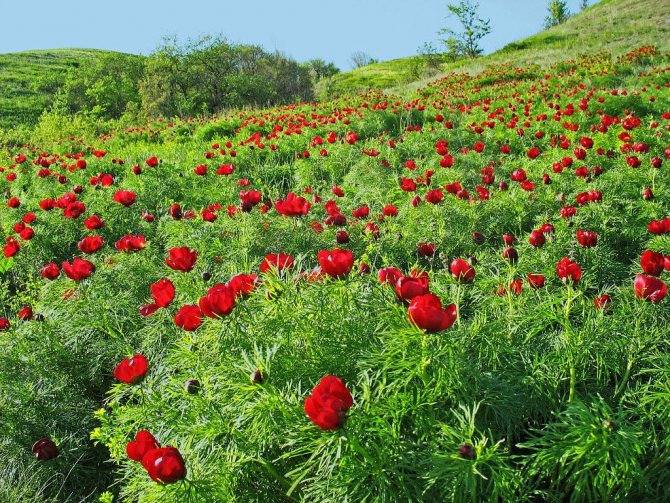

Peonies during flowering
The peony blooms in mid-May - early June, after which the color of the foliage deteriorates, the plant leaves during the summer dormancy, but with continued watering, the bush retains its beauty.
Care during and after flowering
It is not recommended to cut off all flowering shoots, as this will greatly weaken the peony, and it will bloom much weaker next summer. After flowering, you can remove the inflorescences along with part of the stem. Removing the entire stem is not recommended.
If you cut off too many stems, they will have time to regrow and even discard the buds.
Interesting! If, after flowering, the peony is not watered, the plant goes into hibernation, the leaves fall off, the shoots dry up. This state of rest is quite normal.
Peony does not bloom - possible reasons what to do
The main problems due to which the peony does not bloom:
- the seedling is planted too deep;
- the buds are frozen over due to a harsh winter or insufficient plant cover;
- the seedling is weak, planted in poor condition or transplanted several times;
- the bush has aged - in this case, it is required to divide the bush;
- unfortunate place, full shade or bush is flooded with water;
- the plant is sick or damaged by pests.
Reproduction of thin-leaved peony: the most common ways
Such a valuable variety of peony as a thin-leaved one can be bred independently on your site. Of course, you should not go into the forest in search of wild plants, since it is forbidden to pluck them. You can use the existing adult bushes on your site or in the garden with friends. If necessary, you can purchase peony seeds in specialized stores, although the germination rate will be very low. Two methods are suitable for reproduction of the thin-leaved peony: seed and reproduction by dividing the bush. Each option has its own characteristics, which must be taken into account in order to end up with an adult healthy plant.
Seed propagation of thin-leaved peony
- Thin-leaved peony from seeds is grown very rarely, since its seeds have a very low germination rate, especially if you buy them in a store. In addition, you will be able to get a full-fledged plant only after 4-5 years, and you can see the first shoots only after 2 years. The advantage of seed reproduction is the receipt of a large number of valuable seedlings at once.
- First of all, you need to collect seeds if an adult plant grows on your site. It is recommended to harvest them in a slightly unripe state, when the seed pods have not yet opened. This will increase the chance of getting more seedlings.
- After harvesting, the seeds can be sown immediately in open ground, or you can postpone sowing until the fall. In this case, the seeds must be placed in the refrigerator and stored there until planting. This is the only way to preserve the already low germination of fine-leaved peony seeds.
- You can sow seeds before winter, around October-November on a bed with good fertile soil. In this case, the first shoots under favorable circumstances can be seen next spring, but most often they appear only after 2-2.5 years.
- You can sow seeds in winter. This will take a lot of time and patience, but the result will be strong and healthy seedlings.
- First of all, you need to take a flat container and fill it with clean river sand, then moisten it well and sow the seeds.
- Next, you will need a heating pad with a temperature regulator, since in the daytime you need to provide the seeds with a temperature of 30 degrees, and at night - about 15.
- If you don't have such a heating pad, you can use a regular battery. In this case, during the day, the box is placed on the battery, and at night it is transferred to the windowsill.
- During the germination period, it is important to regularly moisten the soil using a spray bottle.
- After the first roots appear, the seedlings are transplanted into boxes with fertile soil and transferred to a cool room with a temperature of 10 degrees. And when leaves appear on the seedlings, the boxes are returned to the warm room again.
- In the second half of August, seedlings can be planted in open ground, where young plants will strengthen the root system before the onset of winter.
- A bush of a thin-leaved peony grown from seeds will bloom only for 4-5 years.
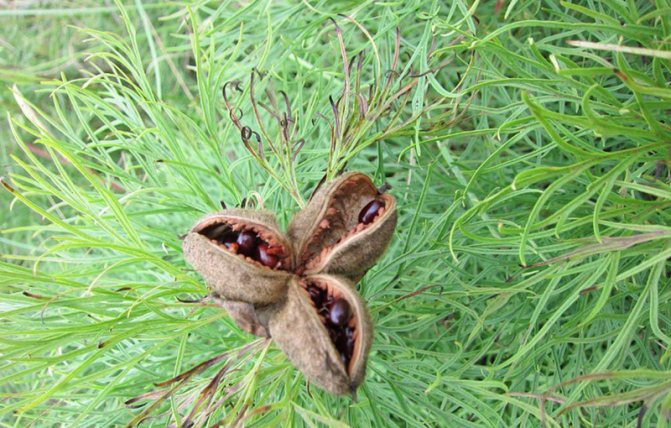

Reproduction of a thin-leaved peony by dividing a bush
- This method of obtaining young strong plants is used much more often, since it requires a minimum of time and effort from the gardener.
- The root system of fine-leaved peony is a tuber consisting of a large number of small adventitious tubers that can be used for plant propagation.
- This method is good because it can be used to rejuvenate an adult plant.
- It is recommended to divide the bush in late August or early autumn, if necessary, you can do this in the spring before the buds appear.
- It is important to remember that only an adult bush that has already reached the age of five can be divided.
- With a shovel, you need to carefully dig out a bush and put it on a piece of cloth or paper. Next, with your hands or pruning shears, you need to divide the root system in such a way that each division has 2-3 buds.
- For planting the cut, small holes are prepared, which are filled with nutritious soil.
- The plots are placed in prepared planting holes and covered with soil so that the buds are about 5 cm above the surface.


Planting with seeds (for breeding)
Peony Felix Krauss (Paeonia Felix Crousse - planting and care
The peony fruit is a star-shaped multileaf, each of which contains several large shiny seeds of black or brown color, from which the species got its name "Voronets".
The time for collecting the planting material is when the fruit bursts and the seeds that are not yet dark are visible through the half-open valves. If you plan to grow seeds in the garden, you need to get them out of the boxes, mulch with wet sand, bark, light soil and refrigerate before planting, not forgetting to control the moisture of the sand all the time.
In the open field, it is enough to sow the seeds in a prepared place in shallow grooves. Sprouts appear in the second year.
For faster germination of peony seeds, three periods are needed - warm-cold-warm.
- In the first warm period, sprinkle the seeds with sand, sprinkle with warm water. Place in a mini greenhouse. It is necessary to maintain the temperature from +16 to +25 degrees, ventilate and moisten the sand until roots 1-2 cm long appear.
- In the cold phase, plants that have developed roots should be planted in peat soil. The temperature should be +6 .. + 10 degrees. Watch out for humidity (it should be about 10%) and for the absence of sudden changes in temperature. The cold phase lasts 3-4 months, daily ventilation is necessary.
- In the second warm phase, growing peony sprouts is no different from growing other plants.
Preparatory work before planting thin-leaved peony
The fine-leaved peony is a rare natural species of this family. However, to date, a large number of hybrid varieties have been bred that can be planted on your site. Like any other plant, the thin-leaved peony requires careful preparation before planting in open ground, the stages of which are important to consider if you want to get a beautiful and healthy young plant.
Stage 1. Selection and purchase of thin-leaved peony seedlings
- First of all, you need to think about purchasing thin-leaved peony seedlings, unless, of course, you are not going to grow them yourself from seeds.
- Since this plant has good resistance to cold and frost, seedlings of any variety of this type are suitable for planting in open ground. Consider what kind of composition you want to get in the end.
- You can buy thin-leaved peonies in specialized garden centers and agricultural firms that are professionally engaged in the cultivation of various plants. This is the only way you will be sure that you are buying exactly the thin-leaved peony sapling.
- Garden shops can sell cuttings of this plant, which must be immediately planted in prepared beds.
- Before purchasing planting material, be sure to check it for damage. The cut tubers should be elastic, without any traces of rot.
Stage 2. Choosing a place for planting thin-leaved peony
- Thin-leaved peony has a very short flowering period, so it is important to carefully choose a place to plant it so that you can at least slightly extend flowering.
- This plant prefers slightly shaded areas of the garden with diffused light.
- It is also recommended to give preference to places with protection from drafts and strong winds. Ideally, this could be a corner in a tree garden.
- You should not plant a peony bush in the near-trunk circle of trees, as they can draw out all the juices and the peony will die.
- This plant loves moisture, so you can choose a place for planting it in the lowlands.
- The fine-leaved peony can be used for planting in flower beds and rocky hills in the background among other flowers.
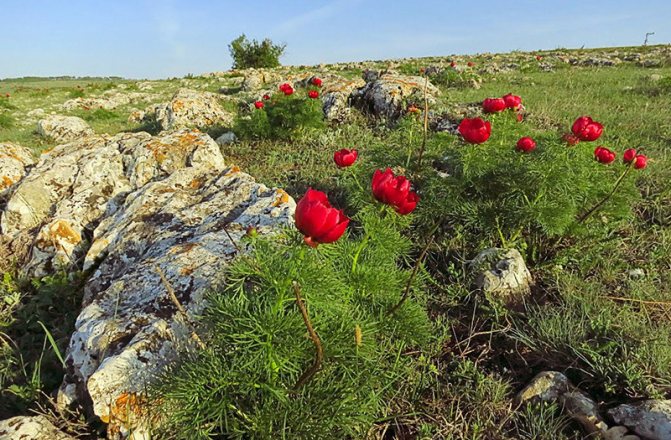

Stage 3. Selection and preparation of soil for planting thin-leaved peony
- The thin-leaved peony is not particularly picky about the soil, however, to increase the flowering period and obtain brighter flowers, it is better to give preference to loamy soil with a large amount of nutrients.
- It is also important to select an area with soil that has a neutral or slightly alkaline reaction. You can navigate by weeds and choose a place where nettles, quinoa, bindweed grow.
- It is important to carefully prepare the selected area before planting. To do this, you need to dig it up, remove all weeds and level it.
Beneficial features
Despite the fact that the considered variety of peonies is poisonous, it contains a lot of substances that can benefit the body. In the field of alternative medicine, the kidneys, roots and leaves of Voronets are often used to prepare lotions, decoctions and tinctures that help with colds, anemia and chronic cough.
Lunar calendar - a flower grower assistant in planting
The fine-leaved peony is considered a very effective analgesic and antispasmodic. However, you should not take it as a remedy for all diseases.
Planting technology of fine-leaved peony
- The best time for planting thin-leaved peony in open ground is late August or early autumn.
- First of all, on a site selected in advance, it is necessary to prepare planting pits, which should be large enough. The depth should be approximately 70 cm and the width 60 cm.
- At the bottom of each planting hole, it is imperative to place a layer of drainage, since this plant, although it loves moisture, does not tolerate its stagnation at the roots.
- Small stones, gravel, broken brick can be used as drainage. The drainage layer should be about 10-15 cm.
- Further, a layer of nutrient soil should be poured into the planting pits, consisting of 1 bucket of humus, 2 tablespoons of wood ash, 100 grams of superphosphate and 50 grams of potassium sulfate. The thickness of this layer should be 15-20 cm.
- After that, ordinary earth, dug earlier, is poured into the pits.
- Next, you can plant thin-leaved peony seedlings. The main thing to remember is that if you are planting cuttings, be sure to sprinkle the cuts with wood ash to prevent decay.
- It is necessary to deepen the plants into the soil no more than 10 cm.
- After planting, it is imperative to make a small hill around the seedlings and sprinkle with humus or peat.


Growing a flower, how to plant it in open ground
The species reproduces by seeds, dividing the bush or root cuttings, stem cuttings, layering.
Planting by root cuttings
Festival Maxima peony (Paeonia Festiva Maxima)
The peony should have at least 2-3 buds on the root collar, the root length should be at least 15 cm.
Small rhizomes with 1-2 buds, if they have at least one root, can also be planted. They are quite viable and root well with a slight delay in the development of the bush.
What time is the boarding
Transplanting, planting and dividing the peony bush is done from mid-August to mid-September. At this time, the growth of overgrowing small roots occurs, due to which the bush is nourished.
Partial rooting of plantings, intensively continuing immediately after thawing of the soil in spring, contributes to a faster onset of peony flowering. At other times, it is necessary to ensure the safety not only of the roots, but also of the shoots.
Location selection
Peonies reach their maximum development at 4–5 years of age and, with good agricultural technology, bloom profusely for another 8–12 years. The plant loves lighted places and reacts to strong darkening with a decrease in the abundance of flowering and paler flowers. A place is chosen taking into account the absence of roots of shrubs, trees and nearby groundwater.
The ideal place is well-lit, with openwork partial shade during the day, away from buildings and large trees, protected from the wind.
Important! Stagnant water and high groundwater levels are unacceptable!
How to prepare the soil for planting
The fleshy perennial roots of peonies with a large supply of nutrients for the normal development of plants require fertile well-cultivated soils and planting places with a depth and diameter of cultivation comparable to the size of the bush and its root system.
The groundwater level should be no higher than 1 meter. The peculiarity of the narrow-leaved peony is that rocky, moderately humid and slightly arid places are permissible.
Growing peonies requires a well-drained soil with good water and air permeability. Drainage from bricks, stones is laid at the bottom of the seats, rusty iron can be added.
On heavy clay soils, sand is added to the pit, on sandy loam and sandy clay. Rotted manure or compost is added to the mixture, per one well, depending on the volume, 100-200 grams of superphosphate, 100-150 grams of potassium sulfate and dolomite flour, lime or ash in acidic soil. Fertilizer dosage is best specified in the instructions. The soil is compacted a little.
The upper part of the pit (15-25 cm) is filled with ordinary fertile soil without fertilizers, and the plant is planted in this layer.
For reference! The recommended soil acidity is slightly acidic (pH 5.5–6.5).
Preparing a seedling for planting
Delenka is examined, damaged and rotten roots are removed, cuts and broken off parts of the root are powdered with ash, charcoal, a means to stimulate growth. Large roots are cut to 1/3 of the length.
Important! The seedlings should be handled carefully, the roots break easily.
Peony planting procedure step by step:
- Choose a place.
- Prepare the planting hole by arranging a drainage layer, fill it with soil and fertilizers. Make a hole.
- Prepare peony seedlings (cuttings, young bush).
- Set the level by marking it with a stretched rope or board
- Place the seedling in the prepared hole, checking the depth of the buds. Large roots are placed in the pit without bending in order to avoid breaking them. The growth points of the seedling should be at a depth of 3-4 cm. After the soil subsides, the seedling settles by 1.5–2 centimeters.
- Cover the hole with fertile soil.
- With your hands, gently squeeze the soil, tamping it around the roots.
- Spill abundantly with water at the rate of 1-2 buckets per plant. If necessary, add more soil if it sags.
- Mulch with compost, straw, peat, chopped bark.
- For late plantings, provide shelter for the seedling.


Delenka-sapling
Agrotechnics of growing thin-leaved peony: secrets and nuances of care
Thin-leaved peony is a rather unpretentious plant to care for, but you still need to pay attention to it if you want to get a beautiful ornamental plant with bright spectacular flowers.
- Watering. Thin-leaved peony is a rather moisture-loving plant, so it must be watered regularly. During the dry summer season, each seedling should be watered about three times a week. However, the main thing in this case is not to overdo it, since stagnant moisture is also destructive to the peony. You can navigate to the soil surface. If it's already dry, it's time to water.
- Loosening and mulching. It is also necessary to loosen the soil around the plants regularly, as peonies prefer to grow in light and airy soil. However, this must be done very carefully so as not to damage the root system of the thin-leaved peony. Near the roots themselves, you need to loosen about 5-7 cm in depth, and a little further - 10 cm.To reduce the amount of watering and remove weeds, experienced gardeners recommend using mulch that prevents moisture from evaporating. Peat or humus can be used as mulch.
- Plant feeding. If you used fertilizers when planting thin-leaved peony in open ground, then the first two years after planting the seedlings will not need nutrients. And from the third year, you can start applying fertilizers. In the spring, under each bush, be sure to add 50 grams of urea and ammonium nitrate. In summer, the thin-leaved peony will not be damaged by the introduction of complex mineral fertilizers. In the autumn, it is recommended to apply phosphorus and potash fertilizers. Avoid too much nitrogen fertilization, as this can reduce the number of buds.
- Transplant of a thin-leaved peony. Periodically, peony bushes need to be rejuvenated and transplanted. This is recommended when the plant reaches 5 years of age. In this case, it is best to choose the autumn period, but spring transplantation is also allowed.
- Disease and pest control. Thin-leaved peony is considered a fairly resistant plant to various pests and diseases, however, if the irrigation regime is not followed, fungal diseases may appear. Also at the beginning of the growing season there is a risk of caterpillars. Therefore, it is recommended to add ash or dolomite flour in the spring.
Diseases and pests
Thin-leaved peony is susceptible to several types of diseases:
- Gray rot. It appears on the deciduous system of a plant from an excess of moisture - excessive watering or prolonged rains. It is easily noticeable, and you can get rid of it by treating the bush with fungicides. If most of the rot has struck, then it is better to remove it, and process the rest of the bush. This will speed up the healing process.
- Rot appears on the root as a result of abundant watering. It becomes soft. Outwardly, this is manifested by blackening of the stem, wilting of the plant. If, when examining the plant, no signs of the disease are noticeable, then the problem is at the root. The flower needs to be dug up and examined. The affected areas are removed, and the cut site is treated with activated carbon. The soil also needs to be disinfected. After that, the plant can be planted in the same hole or dug out another.
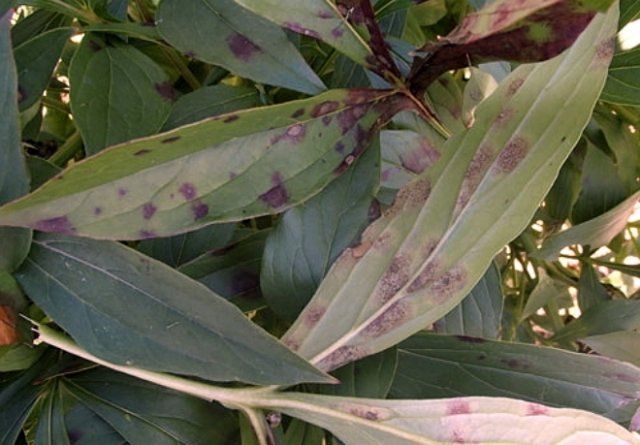

The plant has strong immunity, so diseases rarely affect it. Much more often you can encounter such pests:
- aphid;
- bronze car;
- turf ant;
- caterpillars.
Modern industrial poisons help to get rid of them.
Important. Small numbers of beetles do not harm peonies. Therefore, you should not immediately use the poison. Exposure to poisons will negatively impact vitality. However, with a large number of beetles, processing is inevitable.
Thin-leaved peony - photo
The thin-leaved peony is a flower that has returned from oblivion, which with renewed vigor attracts the attention of numerous gardeners and landscape designers. This is a plant with a bright and unusual appearance, which will certainly become an excellent decoration for your garden or flower garden.
Description of the flower
The thin-leaved peony is famous for its unusual beauty and stunning aroma. The stem can reach a length of 50-60 cm. A distinctive feature of the plant is its leaves - they are narrow, feathery, about 2 mm wide.


What is the fine-leaved peony (Paeonia tenuifolia)
Peonies are perennials, they begin to bloom only for 4-5 years. The buds bloom in the spring, in April-May. The flowers are bright red, large, outwardly reminiscent of poppies. Each has 6-8 petals, in the middle you can see crimson stamens with yellow anthers.
For your information! By the end of summer, a fruit is formed - a polysperm with black shiny seeds.


Flower appearance: petals, stamens, leaves
Other names
Translated from English, the name of the flower is "fern-leaved peony".The Latin name is Paeonia Tenuifolia. The people often call him a crow, an azure flower. Also, the thin-leaved peony is sometimes referred to in the literature as a narrow-leaved, holly, small-leaved or wild peony.
Advantages and disadvantages of the variety
The narrow-leaved peony is characterized by frost resistance and relative unpretentiousness to weather conditions. Prefers fertile non-acidic soils, poorly tolerates excess moisture. Peonies do not take root well on swampy and nitrogen-rich areas of land.
The buds of this plant variety begin to open at the same time, which looks very beautiful. The decorative properties of the flower are enhanced by unusual feathery leaves resembling a fern.
For your information! Peonies are famous for their medicinal properties, thanks to which infusions from different parts of the plant are actively used in folk medicine. In addition, the flower is an excellent honey plant.
Use in landscape design
Gardeners appreciate the plant for its unpretentiousness and unusual beauty. Moreover, the flower belongs to perennials, therefore it will serve as a decoration of the site for several decades. The bushes are decorative from early spring to late autumn, or, as they say, "from snow to snow." Plants fit perfectly into the landscape design of almost any site, not only lush red buds look great, but also leaves, and even fruits.
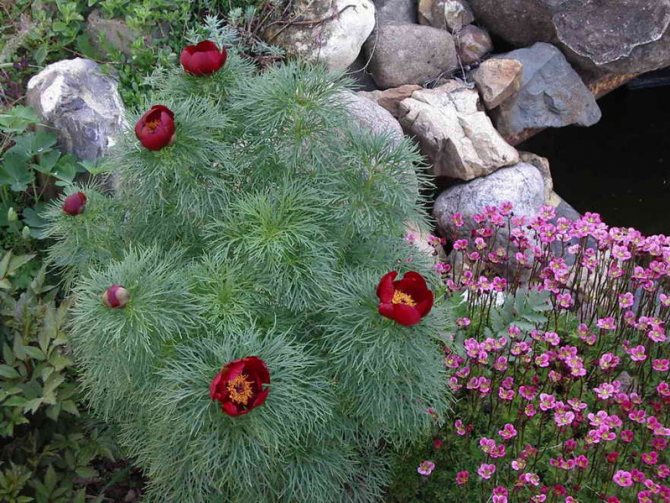

The use of peony in landscape design
Peonies get along well with other plants; bushes can be alternated with plantings of other perennials, for example, tulips. Often they are planted around the perimeter of the lawn, they also look good against the background of conifers.
Reproduction
Usually the peony is propagated by dividing the bush, but sowing seeds can also be used. In early September, when the days are no longer so hot, they plant these flowers by dividing the rhizome. To do this, use old bushes, which are at least 5 years old. The rhizome is divided into several parts so that each has 3 or 4 renewal buds.
For propagation of peony seeds, you must first prepare them. Boxes with this planting material are collected a little unripe, until they are fully opened.
Sowing is carried out at the end of September, so the seeds are carefully packed and stored in the refrigerator until autumn. This method is used mainly for selection, since in this case it is possible only after 3, or even after 4 years, to observe how the narrow-leaved peony blooms.
Contraindications
The use of preparations based on Voronets is contraindicated for pregnant and lactating women, young children. Abuse of these drugs can cause mucosal damage, vomiting, and breathing difficulties.
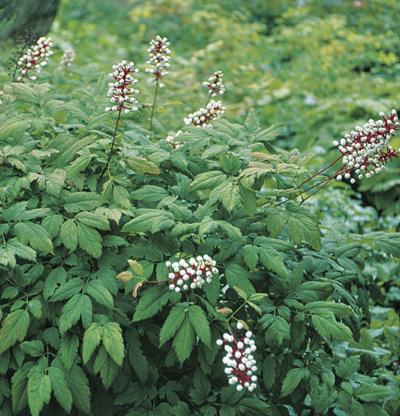

In landscape design, the raven is often used. Photos of compositions with the participation of this plant show how a good partner it is for many garden crops. At the end of summer, when most of the plants have finished their flowering period, the bright fruits of the Voronets delight the eye with their beauty, decorating the garden and adding colors to flower beds.
One of the common garden plants in many European countries is the narrow-leaved peony. In Russia, this plant is less common. It is mainly cultivated by experienced gardeners.


